Effective community growth and resource optimization are essential for sustainable development. This article explores key strategies for fostering collaboration, enhancing communication, and leveraging technology. It also discusses the importance of investing in education, establishing strong leadership, and understanding economic factors. Additionally, it addresses innovative practices and common pitfalls in community initiatives.
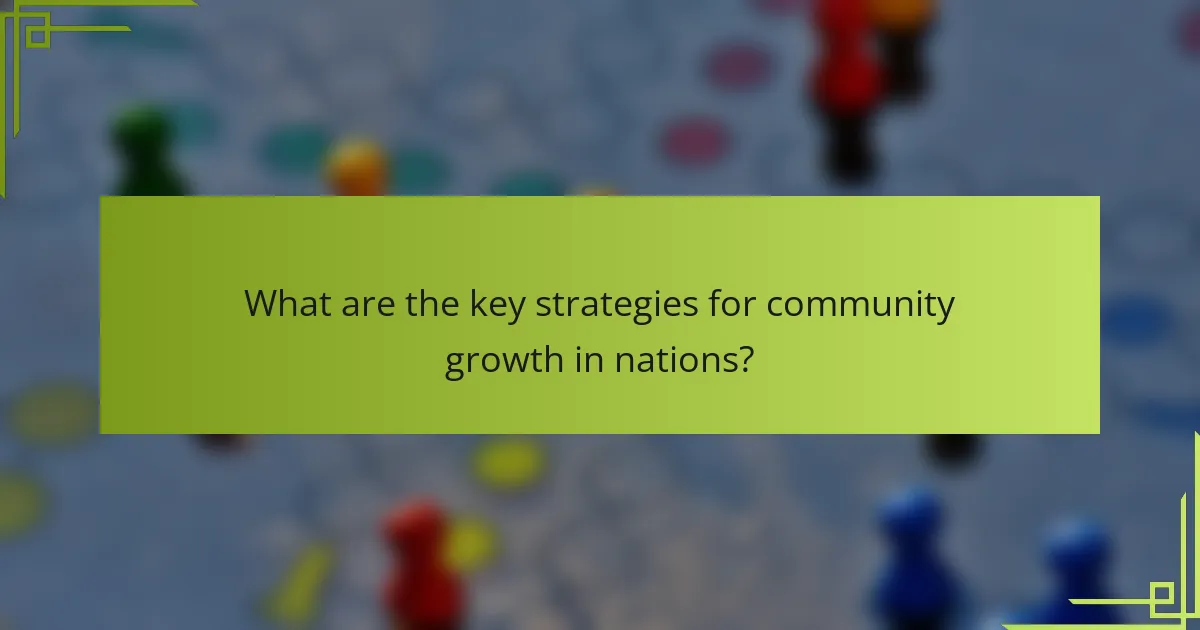
What are the key strategies for community growth in nations?
Key strategies for community growth in nations include fostering collaboration, enhancing communication, and optimizing resource allocation. Communities thrive when individuals engage in collective efforts, share ideas, and utilize available resources efficiently.
Promoting inclusivity strengthens community ties. Engaging diverse groups fosters innovation and broadens perspectives. Additionally, leveraging technology facilitates connectivity, allowing for real-time information sharing and collaboration.
Investing in education and skill development empowers community members. This enhances individual capabilities, driving overall community progress. Furthermore, sustainable practices in resource management ensure long-term viability and resilience.
Finally, establishing clear leadership and governance structures helps in decision-making and conflict resolution. Strong leadership fosters trust and motivates community involvement, essential for sustained growth.
How do cultural factors influence community development strategies?
Cultural factors significantly shape community development strategies by influencing values, priorities, and social structures. Communities with strong cultural identities often prioritize collective goals, fostering cooperation and resource sharing. For example, indigenous practices may emphasize sustainability, guiding development towards eco-friendly initiatives. Additionally, cultural norms affect decision-making processes, determining how resources are allocated and utilized. Understanding these cultural dynamics can lead to more effective and inclusive community growth strategies.
Which role do local governments play in fostering community growth?
Local governments play a crucial role in fostering community growth by implementing policies and programs that support local development. They facilitate infrastructure improvements, promote local businesses, and enhance public services. Through community engagement, local governments identify specific needs and priorities, ensuring that growth strategies align with residents’ interests. Additionally, they often collaborate with other organizations to maximize resources and drive sustainable development initiatives.
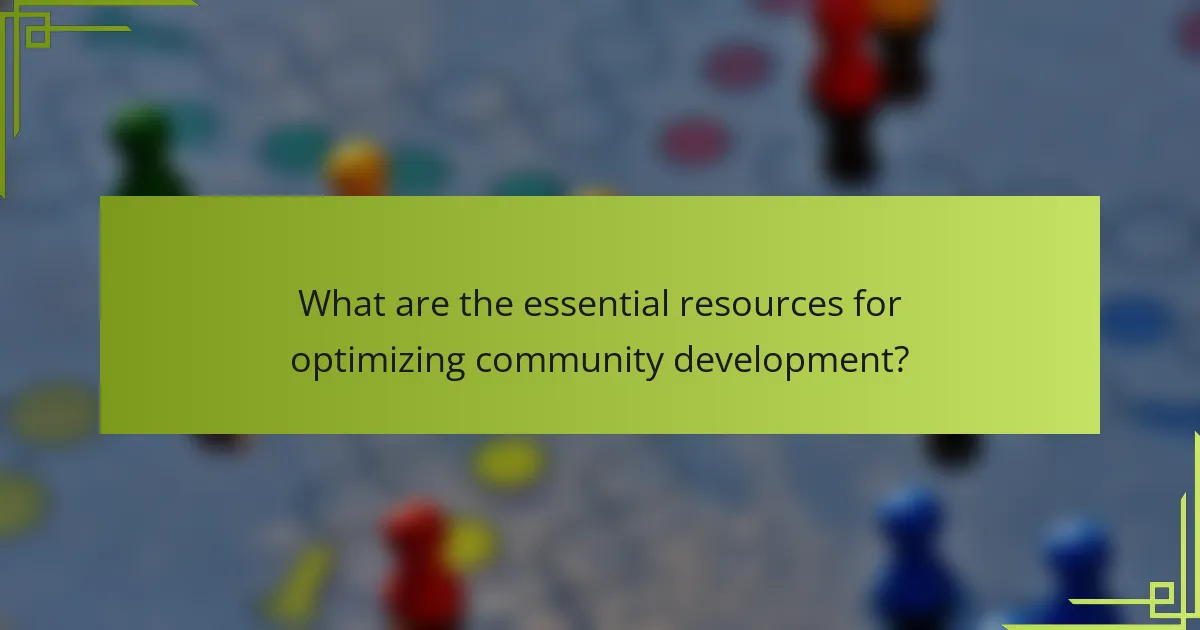
What are the essential resources for optimizing community development?
Essential resources for optimizing community development include strategic planning, effective communication, and collaboration among stakeholders. These elements foster sustainable growth, enhance resource allocation, and improve community engagement.
Key resources are data analytics tools, funding opportunities, training programs, and community networks. Data analytics provides insights for informed decision-making. Funding opportunities support project implementation. Training programs enhance skills and knowledge. Community networks facilitate collaboration and resource sharing.
Investing in these resources leads to increased community resilience and adaptability. Engaging local leaders and organizations strengthens the foundation for long-term success.
How can natural resources be sustainably managed for community benefit?
Sustainable management of natural resources can benefit communities through strategic planning, community involvement, and innovative practices. Engaging local populations ensures that resource management aligns with their needs and priorities. Implementing practices like agroecology enhances biodiversity while maintaining productivity. Additionally, renewable energy initiatives can reduce dependence on non-renewable resources, fostering economic growth and environmental health. Collaborative governance models that include stakeholders promote transparency and accountability, leading to more sustainable outcomes.
What technological resources are vital for modern community optimization?
Technological resources vital for modern community optimization include data analytics, communication platforms, and sustainable energy solutions. Data analytics enhances decision-making by providing insights into community needs. Communication platforms facilitate collaboration and engagement among residents. Sustainable energy solutions promote eco-friendly practices, reducing costs and environmental impact. These resources collectively support efficient community growth and resource management.

How do economic factors affect resource allocation in community growth?
Economic factors significantly influence resource allocation for community growth by determining investment levels and prioritizing development projects. Economic stability attracts funding, while fluctuations can hinder progress. For instance, regions with higher income levels can allocate more resources to infrastructure, education, and healthcare, fostering sustainable growth. Additionally, local job markets and employment rates dictate resource distribution, ensuring that communities can meet their residents’ needs effectively. Ultimately, understanding these dynamics helps in strategizing for optimal resource optimization in community development.
What are the impacts of local economies on resource optimization?
Local economies significantly influence resource optimization by enhancing community engagement and promoting sustainable practices. Strong local economies encourage efficient resource allocation, reducing waste and fostering innovation. For example, local businesses often prioritize sourcing materials from nearby suppliers, minimizing transportation costs and environmental impact. Additionally, community-driven initiatives can lead to shared resources, such as tool libraries or community gardens, optimizing usage and reducing individual expenditures. The unique attribute of localized decision-making allows for tailored solutions that address specific community needs, ultimately driving long-term sustainability.
How can communities leverage partnerships for economic growth?
Communities can leverage partnerships for economic growth by fostering collaboration among local businesses, governments, and organizations. These partnerships enhance resource sharing, improve access to funding, and create opportunities for innovation. For example, joint ventures can lead to new products and services that meet community needs. Collaborations can also attract external investments, boosting local economies. Engaging in strategic alliances helps communities optimize resources and build resilience against economic challenges.
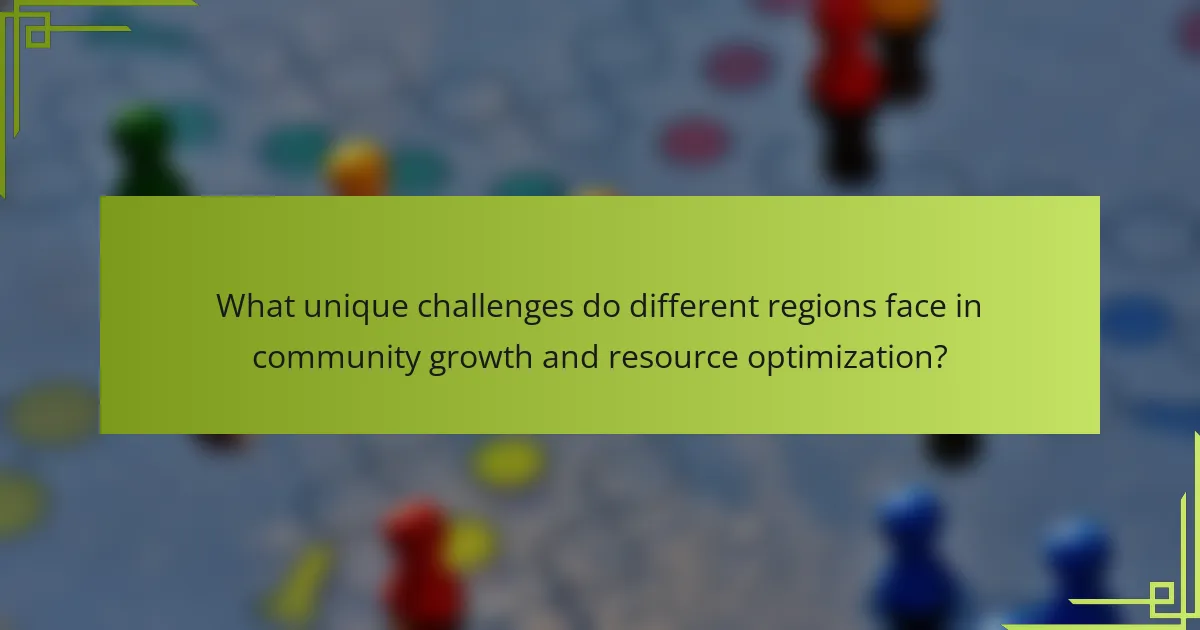
What unique challenges do different regions face in community growth and resource optimization?
Different regions face unique challenges in community growth and resource optimization based on their geographical, economic, and social contexts. Urban areas may struggle with overcrowding and infrastructure demands, while rural regions often deal with limited access to services and economic opportunities.
For instance, coastal communities may face environmental threats like rising sea levels, impacting resource availability. In contrast, mountainous regions might encounter isolation, limiting trade and collaboration. Economic disparities can hinder resource optimization, as wealthier areas often attract more investment.
Cultural differences also play a role; communities with strong local traditions may resist external influences that could foster growth. Understanding these regional challenges is crucial for developing tailored strategies that promote sustainable community development and efficient resource management.
How do urban and rural areas differ in their growth strategies?
Urban and rural areas differ significantly in their growth strategies due to varying resource availability and community needs. Urban areas often focus on infrastructure development and technological integration, emphasizing economic diversification. In contrast, rural areas prioritize agricultural sustainability and community engagement, leveraging local resources for growth.
Urban growth strategies frequently involve public-private partnerships to enhance service delivery and investment in smart city initiatives. For example, cities may implement zoning reforms to encourage mixed-use developments. Rural strategies, however, might include cooperative models that empower local farmers and artisans, promoting self-sufficiency.
Additionally, urban areas typically experience faster population growth, necessitating rapid adaptation of services and housing. Conversely, rural areas face challenges like depopulation, leading to strategies that attract residents through improved quality of life and economic opportunities.
These differences highlight the unique attributes of each area, shaping their respective growth trajectories and resource optimization approaches.
What are some case studies of successful community growth in diverse regions?
Successful community growth strategies vary across diverse regions, showcasing unique approaches. Case studies include:
1. **India’s Digital Initiatives**: Leveraging mobile technology, communities improved communication and resource sharing, enhancing local economies.
2. **Rural Development in Brazil**: Cooperative farming models increased food production and empowered local farmers, fostering economic resilience.
3. **Urban Revitalization in Detroit**: Community-led projects transformed vacant lots into green spaces, promoting social cohesion and local engagement.
4. **Tech Hubs in Kenya**: Nairobi’s tech ecosystem attracted investments, creating jobs and fostering innovation through collaboration among startups.
5. **Cultural Heritage in Japan**: Local festivals and traditions were revitalized, strengthening community identity and attracting tourism.
6. **Sustainable Practices in Sweden**: Eco-villages implemented renewable energy solutions, promoting environmental stewardship and community well-being.
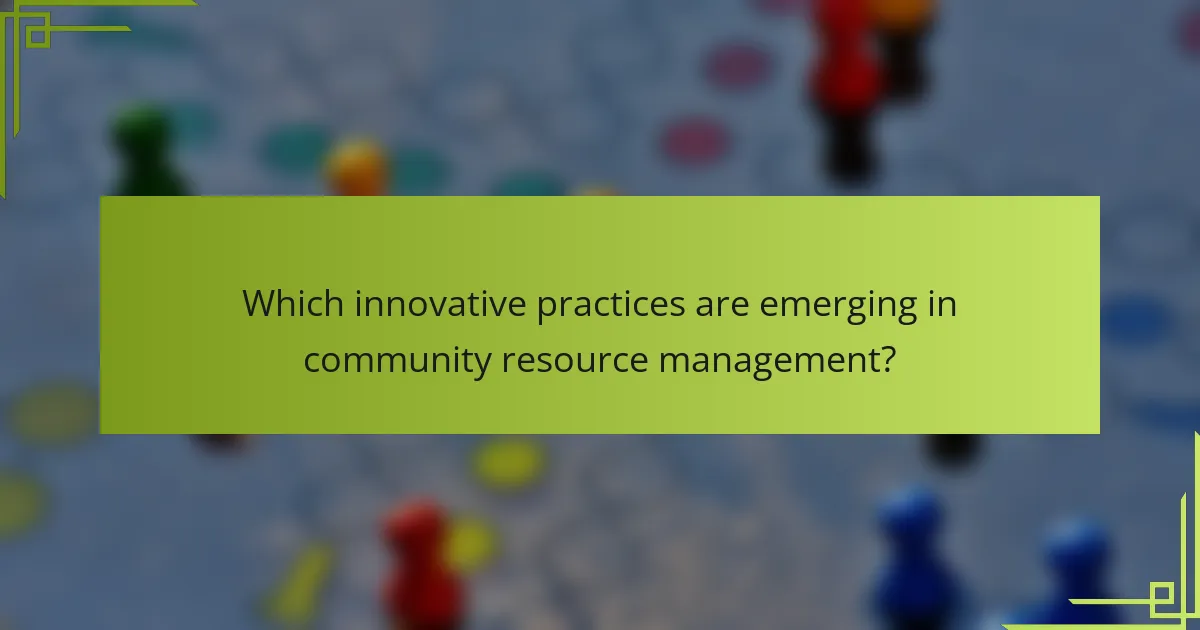
Which innovative practices are emerging in community resource management?
Innovative practices in community resource management focus on sustainability, technology integration, and participatory governance. For example, community-led renewable energy projects empower residents while optimizing local resources. Digital platforms facilitate resource sharing and enhance collaboration among community members. Additionally, data-driven decision-making improves resource allocation and management efficiency. These approaches foster resilience and adaptability in communities facing environmental and economic challenges.
What role does community engagement play in resource optimization?
Community engagement significantly enhances resource optimization by fostering collaboration and sharing knowledge among participants. Engaged communities can identify resource needs more effectively, leading to better allocation and utilization. For instance, local groups often collaborate to pool resources, reducing waste and increasing efficiency. This collective effort can result in innovative solutions that may not arise in isolated settings. Additionally, community members may contribute unique insights, improving decision-making processes and outcomes. Ultimately, active participation strengthens the overall sustainability of resource management strategies.
How can data-driven decision-making enhance community growth strategies?
Data-driven decision-making significantly enhances community growth strategies by providing actionable insights. It allows leaders to identify trends, allocate resources efficiently, and tailor initiatives based on community needs. By analyzing data, communities optimize engagement and foster collaboration, leading to sustainable growth. For instance, tracking participation metrics can reveal effective outreach methods, ensuring resources are directed where they yield the highest impact.
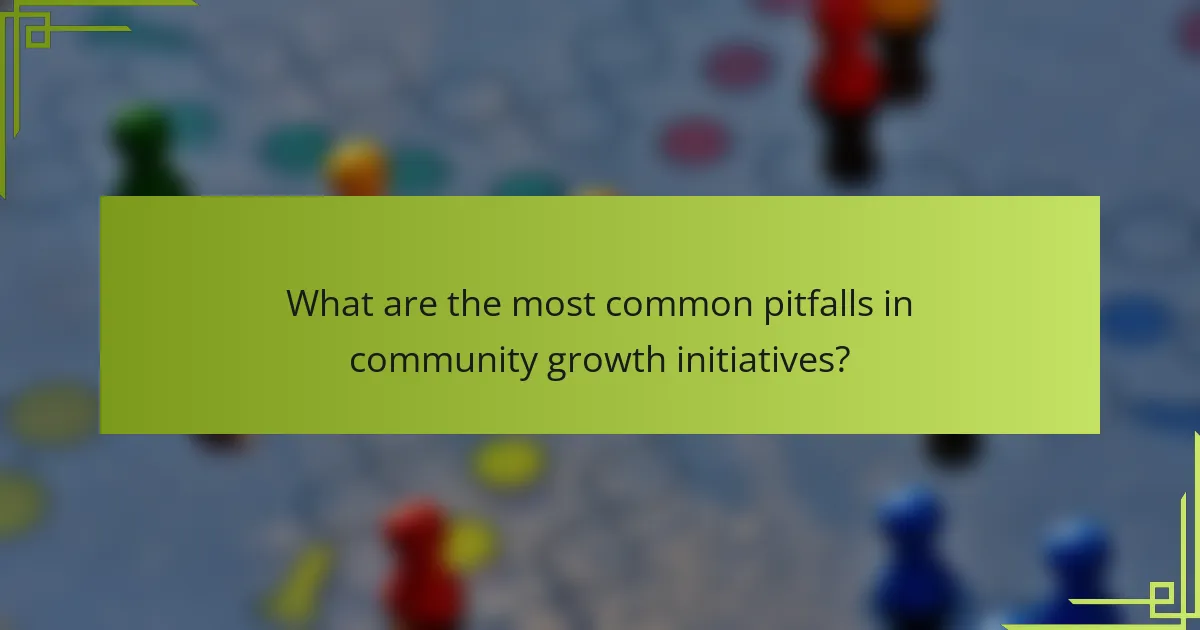
What are the most common pitfalls in community growth initiatives?
Common pitfalls in community growth initiatives include lack of clear goals, insufficient engagement strategies, neglecting feedback, and overlooking resource allocation. These issues hinder sustainable growth and diminish member satisfaction. For instance, unclear goals can lead to misaligned efforts, while inadequate engagement can result in dwindling participation. Prioritizing feedback ensures that community needs are met, and proper resource allocation maximizes impact. Addressing these pitfalls is crucial for effective community growth and resource optimization.
How can communities avoid misallocation of resources?
Communities can avoid misallocation of resources by implementing strategic planning and data-driven decision-making. Establishing clear priorities ensures that resources align with community needs. Regular assessments of resource utilization can identify inefficiencies, allowing for timely adjustments. Engaging community members fosters transparency and collaboration, enhancing resource allocation accuracy. Utilizing technology for tracking and analysis supports informed choices, promoting optimal growth and sustainability.
What lessons can be learned from failed community development projects?
Failed community development projects highlight critical lessons for future initiatives. Key lessons include the importance of community engagement, clear goal setting, and sustainable resource management.
1. Community Engagement: Involving local residents in the planning process fosters ownership and ensures that projects meet actual needs.
2. Clear Goals: Establishing specific, measurable objectives helps maintain focus and assess progress effectively.
3. Sustainable Practices: Prioritizing long-term resource management prevents depletion and supports ongoing community benefits.
4. Flexibility: Adapting to changing circumstances and feedback can enhance project outcomes and resilience.
5. Evaluation Mechanisms: Implementing robust evaluation processes allows for learning from failures and successes, guiding future efforts.
What are the best practices for sustainable community growth and resource optimization?
To achieve sustainable community growth and optimize resources, focus on strategic planning, community engagement, and efficient resource management. Prioritize inclusive decision-making to ensure diverse perspectives contribute to development.
1. Foster collaboration among stakeholders to leverage shared resources and expertise.
2. Implement green technologies to reduce environmental impact and enhance sustainability.
3. Encourage local entrepreneurship to stimulate economic growth and create job opportunities.
4. Monitor and evaluate community initiatives to assess effectiveness and adapt strategies as needed.